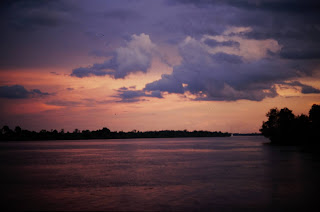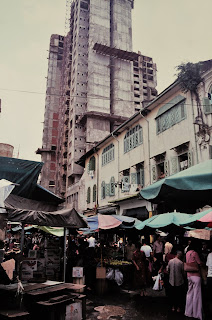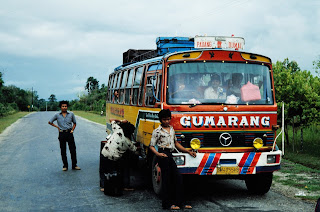Between Singapore and Sumatra
The state of Indonesia is scattered over more than 17.000 Islands. The biggest only owned by Indonesia are Java and Sumatra, Kalimantaan (Borneo) is shared with Malaysia, New Guinea (Irian Jaya) with the state of Papua New Guinea.
Rice terraces n Sumatra
“The entire tropical archipelago extends for more than 45 degrees of longitude, one eighth of the entire globe, covering three time zones and more than 5000 kilometers along the equator. Projected onto a map of Europe it would start in Ireland and end somewhere in Kasachstan” David van Reybrouck
Lake Toba on Sumatra
In 1982 Sumatra still was a quite remote place with most of its surface covered in either tropical jungle or swamps, where specific subspecies of tigers, rhinos, elephants and orang utans were roaming. In the last 35 years the island has lost 50% of its tropical rain forest cover and all these species are critically endangered.
New Skyscraper behind old colonial buildings in Singapore
We did not choose the easiest way to enter Indonesia. From Singapore, we decided to take a boat. An archipelago of 1,796 islands lies scattered between Sumatra, the Malay Peninsula, and Borneo. To go oversea, it was necessary to take a boat from Singapore to Tanjung Pinang, the capital of the Riau archipelago, stay a couple of nights and then continue on another boat to Pekambaru in Sumatra.
Meanwhile all the old neighborhoods have disappeared from the centre
First we had to get a visa in the indonesian embassy in Singapore. The worst thing was that we had to go there twice, first to fill in the application and the next day to collect the passport. When we arrived, hundreds of people were waiting to be helped by unfriendly and unmotivated staff working with utmost sluggishness. According to the diary I wanted to give everyone a kick in the ass to speed things up.
Looking for the way in the 80ties
We wanted to pick up the passports in the morning of the day the boat to Tanjung Pinang was supposed to leave. If there was a boat to Tanjung Pinang at all since there were elections in Indonesia and nobody could actually tell us whether the boat would leave. So we had to get up early. Both of our watches were broken after they got too much water during the celebrations of Bhuddist new year in Thailand some weeks before. Getting up in time was guess work since the guesthouse didn‘t have a clock either. Nevertheless we were there before opening time. However the majority of the embassy staff was late for work, and in particular the guy we needed was the last to show up.
Old market in Singapore
Eventually we arrived at a boat full of suitcases, but few passengers. The Riau islands are a popular stopover for smuggling from the cheap shopping paradise of Singapore into Indonesia. Eventually we set off and the boat zigzagged along all the freighters waiting to be loaded or unloaded off the port proper. Eventually we reached indonesian waters and it did not take a long time until an indonesian customs boat appeared. The boat went alongside and one of our boatmen jumped over to handle the affair. Bribes had to be paid for all the contraband smuggled in the suitcases.
One of the boats between Singapore and Sumatra
It is only around 70 km from Singapore to Tanjung Pinang. During the 4 h ride on a mirror like sea the ferry passes small islands but also fishing huts on poles which seem to survive in the middle of the ocean. Our smugglers have bad luck. Another customs boat appears and they have to pay again.
Loading the boat
In the 16th century the Riau Islands became the centre of the Johor sultanate, and as such also the centre of Malay culture. Riau became a centre of Islamic studies and attracted Muslim scholars from India and Arabia as well as Sufi devotees. End of the 18th century the Dutch and the British took advantage of a crisis in succession. The area was important for the trade of both colonial powers. Both installed their own sultan in their respective territory. Eventually the conflict was solved in 1824 with a Anglo-Dutch treaty, whereby the area north of the Singapore strait became under British and the Riau Islands under Dutch influence. Formally, the sultanate stayed in power under the protection of the Dutch. End of the nineteenth century, however, resistance against the colonial supremacy rose. Although the resistance was non-violent and resorted to measures like refusing to hoist the Dutch flag, the Dutch landed a military force in 1911 and seized the islands. To avoid blood-shed the Sultan left without a fight and went into exile in Singapore.
“A crossroads of civilizations, that was the archipelago. in the harbours, not only passed by goods, but also gods” David van Reybrouck
One of the 1759 islands of the Riau Archipelago
On the boat we have made a couple of new friends and when we eventually arrive in Tanjung Pinang we share a room in a guesthouse with Dick, a guy from England, and a newspaper reporter from NZ on a short excursion.
A hut in the middle of the ocean
Dick is one of those phenomenons you sometimes meet abroad. A big, bearded, blond Englishman wearing shorts, heavy army boots and a worn out green floppy hat. He speaks German, Suaheli, French and Spanish and is busy learning Indonesian. His clumsiness, nonchalance and childishness together with his size make him the proverbial elephant in the china store. However, his openness, spontaneity, unselfconsciousness and talkativeness immediately wins him friends and so he is constantly surrounded by a group of the curious. He is anaesthetist but his general knowledge is admirable. For the next days he will be our companion.
This is how the villages in Riau looked like. Look for a comparison with today in Google
The guest house is on poles above the mud. To get there you have to walk over a boardwalk above a stinking black muck full of garbage. It is also the destination of the produce of the suspended toilets. The sickly smell will not leave us on these islands. It is the last you notice before falling asleep and the first after waking up.
The beach of my encounter with the jelly fish
While trying to fall asleep we can hear that the muck is alive. It is home for millions of rats which do not even pretend to hide. The garbage cans, always full, are the meeting point of huge brown beetles, which hastily try to get out of the way when one of the many stray dogs rummage around in the contents. Cadavers of cats and dogs lie in the street. It is not always clear whether they are dead or alive.
Main street
During the day the streets are filled by hordes of moped drivers who recklessly honk their horns to chase everything out of their way. The smell of exhaust adds to the stink of the garbage, the scent of the masses, the dust, the heat, humidity and noise. Everybody seems to shout or to produce noise. But we find a guy in the street who is able to repair watches. My friend Herbert trusts him, gets his watch repaired and it worked for many years after that. I did not get mine repaired and nobody in the highly developed Europe was either willing or able to repair it later.
The watch maker
Like the rest of South-East Asia the Riau Islands were occupied by the Japanese during WW II.
During this time they had organised and trained the youth in groups called Pemoeda’s. When the Japanese were forced out, the Republicans under Soekarna who strived for independence could count on hundreds of thousands trained and aggressive fighters. It was a fatal illusion of Dutch politicians and generals that a restoration of their colonial power was possible. On the Riau islands, a royalist group attempted the restoration of the former Sultanate, albeit independent but under Dutch colonial rule. This was not welcomed by the indonesian republican movement. After the official withdrawal by the Dutch in 1950, the Riau Archipelago became one of the last territories to be absorbed into the United States of Indonesia. The leader of the Riau forces, Major Raja Muhammad Yunus, who led the bid to reestablish the sultanate apart from Indonesia fled into exile in Johor after his ill attempt.
Meanwhile most of the old-fashioned shops have given way to Malls
On an archipelago of 1796 islands it should be possible to find a beach. What we find is only a narrow strip of mud and murky water so shallow that I can still stand after walking 600 steps. Eventually I swim towards a patrol boat of the Navy. When I finally turn around I have to fight against a strong offshore current due to low tide. Suddenly I feel a strong pain in my arm, probably from an encounter with a jelly fish invisible in the clowdy water. Since I have problems moving the arm I have difficulties to get back to shore. Big parts of the arm get covered with red spots which spread out quickly. My skin feels like it is punctured from inside the body with needles. One of the friendly and helpful locals comforts me with the information that an encounter of the heart or breast area with a jelly fish would have been fatal. However, fortunately the irritation quickly disappears .
At night there are lots of food stalls. Nobody seems to understand me. When I sit down and order tea I get some kind of overpriced cacao. In 1982 I had no idea about asian food. Even a wok was a new experience. In Tanjung Pinang we have a soup with a huge fish head for dinner, and I marvel at a chinese hot-pot, here called steam boat. They charge 4000 rupies for dinner, that is 4 times of what they charge each of us for our room. Not surprising, because when walking back over the boardwalk on poles to our guest house the smell gets so unbearable that it is difficult to keep the dinner inside long enough for digestion.
In the humidity and heat carrying even a small backpack to the boat which will bring us to Sumatra is a sweaty torture. The pier is full of waiting passengers. The ground is wet and dirty. I squeeze myself next to two other tourists onto a dusty linen sack. My stuff has to end up on the mucky floor. When the boat has finally docked after a complicated manoeuvre, the masses storm the deck. Like a waterfall the people rush from the high jetty into a far too small boat. Pieces of luggage, boxes, baskets, mattresses and suitcases are thrown on deck. Everything is full. In a cabin for 16 there are at least 30. An old woman gesticulating with the ticket in her hand is upset about something and screams it out. Children cry, men yell. The accompanying mothers chatter. There is no attempt to calm the kids.
Village along the river on the route t Pekambaru
The tickets have to be presented several times but the cabin does not get emptier. Mats are spread out and territories are claimed with barricades of suitcases and boxes. We feel like being absorbed and slowly swallowed in a human swamp. It is asphyxiating.
The boats are rowed standing
Outside it is not better. Human bodies are occupying every free space. And all make some noise. If you sit down you are immediately wedged into a mass of bodies and the heat gets even worse. Our hope that it gets better after the boat leaves the port is vain. Outside it gets fuller since people come to get some fresh air. There is no shade or shelter from the burning sun alternating with torrential rain showers. We will have to bear that for the trip lasting supposedly 50 hours. Fortunately we have Dick around, who not only has an endless number of stories, but also explains the stars at night and suddenly starts to sing folk songs in German.
Sunset above the river
Soon a custom boat comes alongside again. This time there is no chance for the smugglers to bail out. The customs officers board and search the ship for an hour. Three old woman (professionals, grumbles my neighbour) run into problems but are allowed to continue.
The next rain cloud is never far away
Our new friend Dick is very occupied with his health. He is convinced that cocos milk from freshly opened nuts is the only healthy drink on the boat. No wonder his diarrhoea has a cocos smell. To everybody’s general amazement he uses every stop of the boat for a swim, jumping overboard in his clothes without worry for his possessions staying behind or how he will get back on again.
This worked without problem for several times until the boat is stopped again by another customs boat downriver from Pekambaru. After jumping overboard the strong current carries him away. People shout and point at his head quickly disappearing downriver. The customs boat quickly takes off and pursues the head for rescue. Back on board the soaked Englishmen is welcomed with laughter.
Bus to the interior at a gas station
Eventually we arrive in Pekambaru in the middle of the night. It is raining cats and dogs. The tourists are allowed to pass the customs without much delay and we take a taxi to the bus station to get out of this industrial town as quickly as possible. We have lost Dick but have brought some of his stuff he forgot on the boat. Eventually he joins up with us again, in his arms a coconut which he devours while we wait for the bus. But apparently his tummy did not tolerate the one-sided diet any more and he quickly disappears to the toilet. Meanwhile the bus is ready to depart. When he comes back he has forgotten his backpack. Eventually, after he has assembled all his belongings, the bus can depart. After 7 hours of mountain road in a bus full with vomiting passengers, we are glad to arrive in Bukkittingi with an aching bud.
“indonesian history contains a first of world importance, it was the first country to declare its independence after the second world war” David van Reybrouck
Woman in Sumatra
In 2020, the Belgian historian David van Reybrouck published “Revolusi”, an extensive book about the indonesian struggle for independence. In the Netherlands not everybody appreciated this first independent study about the end of the Dutch rule in Indonesia. A well known right wing politician twittered: “I think that this idiot first should write a book about king Leopold and the Belgian Congo before he gives his opinion”. Apparently this politician was ignorant of a similar extensive study about Congo published by van Reybrouck some years before. In the Binnenhof, the Dutch parliament, the entrance through which the well known conservative politician enters, is the former entrance of the ministry of the colonies. Above the entrance there is a relief which shows colonial officials under the shade of parasols and fans carried by their slaves.
Entrance to the former ministry for the colonies in The Hague
“When the Rijksmuseum reopened after a sound renovation in 2013, only 1 of the 65 renovated rooms was dedicated to colonial history” David van Reybrouck
School children in their outfit in Sumatra
In his book van Reybrouck draws an interesting comparison between the indonesian revolution and the present struggle for more attention for climate and environment. The indonesian revolution was successful because of the mobilisation and sacrifices of the young people organised in the Pemoeda’s.
“... the revolusi of 1945 was in every way a revolution of the youth. Anyone who thinks today that young people cannot make a difference in the fight against global warming and the loss of biodiversity should urgently delve into Indonesian history: the world's fourth-largest country wouldn't have come into existence without the support of teens and early twenties - though I hope the youthful climate activists adopt less violent tactics” David van Reybrouck
Family in Sumatra
While reading van Reybrouck’s book I became interested in the issue and looked for a museum which gives a fair account of colonial Dutch history. There is of course the Tropenmuseum in Amsterdam, but it focusses on culture and arts and bypasses history. However, eventually I found Museum Sophiahof, the Museum of the Moluk community in the Netherlands in the Hague. .
Museum Sophiahof in The Hague
At the moment they have a fascinating exhibition about the fate of the community of Depok, a plantation in Java. In the 17th century, in his will, the owner, Cornelis Castelijn, decreed that after his death the slaves had to be set free and became common owners of the plantation as long as they lived on the ground. However, after his death, the Council of the Dutch Indies did not accept the will. Only as late as 1850 the Dutch high court decided, that the claims of the descendants of the former slaves was justified and the land was reinstituted. As landowners, christians and partially with Dutch origin the descendants of the former slaves had to bear the consequences of their past until far beyond the colonial time. Marked as collaborators and traitors, they lost their land again after independence. Many left Indonesia in fear of persecution. Those who left were not well received in the Netherlands, where they were still considered as former slaves. Colonialism and slavery caused a whole group of people to be caught in the confusion of world politics.
Sources
Museum Sophiahof, Depokkers, een colonial verhaal ontrafeld, exhibitin catalogue, 2020.
David van Reybrouck, Redvolusi, Debezigebij, 2020
Link to the previous post:






























